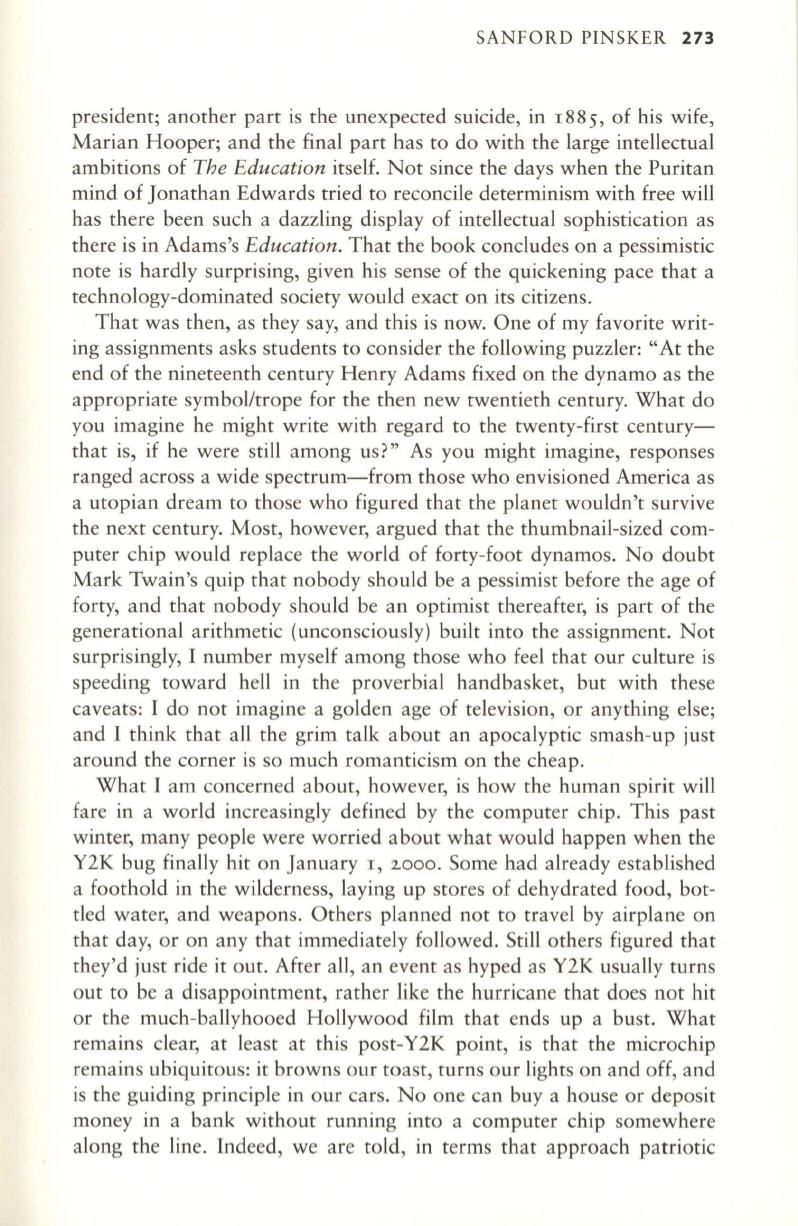
SANFORD PINSKER
273
president; another part is the unexpected suicide, in
1885,
of his wife,
Marian Hooper; and the final part has to do with the large intellectual
ambitions of
The Education
itself. Not since the days when the Puritan
mind of Jonathan Edwards tried to reconcile determinism with free will
has there been such a dazzling display of intellectual sophistication as
there is in Adams's
Education.
That the book concludes on a pessimistic
note is hardly surprising, given his sense of the quickening pace that a
technology-dominated society would exact on its citizens.
That was then, as they say, and this is now. One of my favorite writ–
ing assignments asks students to consider the following puzzler: "At the
end of the nineteenth century Henry Adams fixed on the dynamo as the
appropriate symbol/trope for the then new twentieth century. What do
you imagine he might write with regard to the twenty-first century–
that is, if he were still among us?" As you might imagine, responses
ranged across a wide spectrum-from those who envisioned America as
a utopian dream to those who figured that the planet wouldn't survive
the next century. Most, however, argued that the thumbnail-sized com–
puter chip would replace the world of forty-foot dynamos. No doubt
Mark Twain's quip that nobody should be a pessimist before the age of
forty, and that nobody should be an optimist thereafter, is part of the
generational arithmetic (unconsciously) built into the assignment. Not
surprisingly, I number myself among those who feel that our culture is
speeding toward hell in the proverbial handbasket, but with these
caveats: I do not imagine a golden age of television, or anything else;
and I think that all the grim talk about an apocalyptic smash-up just
around the corner is so much romanticism on the cheap.
What I am concerned about, however, is how the human spirit will
fare in a world increasingly defined by the computer chip. This past
winter, many people were worried about what would happen when the
Y2K bug finally hit on January
I, 2000.
Some had already established
a foothold in the wilderness, laying up stores of dehydrated food, bot–
tled water, and weapons. Others planned not to travel by airplane on
that day, or on any that immediately followed. Still others figured that
they'd just ride it out. After all, an event as hyped as Y2K usually turns
out to be a disappointment, rather like the hurricane that does not hit
or the much-ballyhooed Hollywood film that ends up a bust. What
remains clear, at least at this post-Y2K point, is that the microchip
remains ubiquitous: it browns our toast, turns our lights on and off, and
is the guiding principle in our cars. No one can buy a house or deposit
money in a bank without running into a computer chip somewhere
along the line. Indeed, we are told, in terms that approach patriotic


